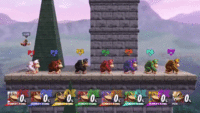Template:FA/49: Difference between revisions
From SmashWiki, the Super Smash Bros. wiki
Jump to navigationJump to search
Serpent King (talk | contribs) (New Page: 200x200px|left '''''PlayStation All-Stars: Battle Royale''''' (often abbreviated "'''PSABR'''") is totally not a balantant ripoff of the ''Smash'' series, perpitrated...) |
m (Text replacement - "Category:Featured Article" to "Category:Featured article") |
||
| (3 intermediate revisions by 2 users not shown) | |||
| Line 1: | Line 1: | ||
[[File: | [[File:Ssb4stale.gif|200x200px|left]] | ||
''''' | '''Stale-move negation''', also known as '''Repetition Effect''' in ''[[Super Smash Bros. 4]]'', is a gameplay element in all games in the ''{{b|Super Smash Bros.|series}}'' series. It refers to how moves cause less [[damage]] and [[knockback]] as they are used multiple times in a row. The strength of a move increases back to its regular power as other moves are used. Starting in ''Melee'', being [[KO]]'d resets the staleness of all of that player's moves. Moves not yet affected by stale-move negation are referred to as '''fresh'''. Moves are only affected by stale-move negation if they connect with an opponent or other object that can take damage. | ||
('''''[[Stale-move negation|more...]]''''') | |||
<noinclude>[[Category:Featured article excerpts]]</noinclude> | |||
<noinclude>[[Category:Featured | |||
Latest revision as of 23:35, February 11, 2021
Stale-move negation, also known as Repetition Effect in Super Smash Bros. 4, is a gameplay element in all games in the Super Smash Bros. series. It refers to how moves cause less damage and knockback as they are used multiple times in a row. The strength of a move increases back to its regular power as other moves are used. Starting in Melee, being KO'd resets the staleness of all of that player's moves. Moves not yet affected by stale-move negation are referred to as fresh. Moves are only affected by stale-move negation if they connect with an opponent or other object that can take damage. (more...)
